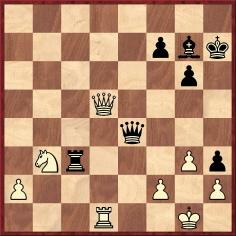
Edward Winter
From Eduardo Bauzá Mercére (New York, NY, USA):
‘There are a few games with a Novotny interference move, but only one widely-known practical example of the Plachutta sub-category (where a piece is offered on a square where it can be captured by either of two pieces which move similarly): Tarrasch’s win over consultants in 1914, a game discussed in C.N.s 5161, 6279 and 7050.’
Our correspondent offers another example, from El Ajedrez Americano, June 1929, pages 181-182:
Benito Higinio Villegas – Carlos M. Portela1 Nf3 d5 2 d4 c6 3 e3 g6 4 c4 Nf6 5 Nc3 Bg7 6 cxd5 cxd5 7 Bb5+ Bd7 8 Qb3 O-O 9 Bxd7 Qxd7 10 Ne5 Qc7 11 Bd2 e6 12 Rc1 Nc6 13 Na4 Ne4 14 Nxc6 Nxd2 15 Qb4 bxc6 16 Qxd2 e5 17 O-O exd4 18 exd4 Qd6 19 Rfd1 Rfe8 20 Nc5 Re7 21 Re1 Rae8 22 Rxe7 Qxe7 23 g3 Qe2 24 Qc3 h5 25 Nb3 Bh6 26 Rf1 Re6 27 Nc5 Re3 28 Qa5 Rf3 29 Qa6 Qxb2 30 Qxc6 Qxd4 31 Nb3 Qe5 32 Qa8+ Kh7 33 Qxa7 Bg7 34 Qa5 h4 35 Qe1 Qf5 36 Qe2 h3 37 Rd1 Rc3 38 Qd2 Qf3 39 Qxd5 Qe2 40 Qd2 Qf3 41 Qd5 Qe2 42 Qd2 Qe4 43 Qd5

43...Rd3 44 White resigns.
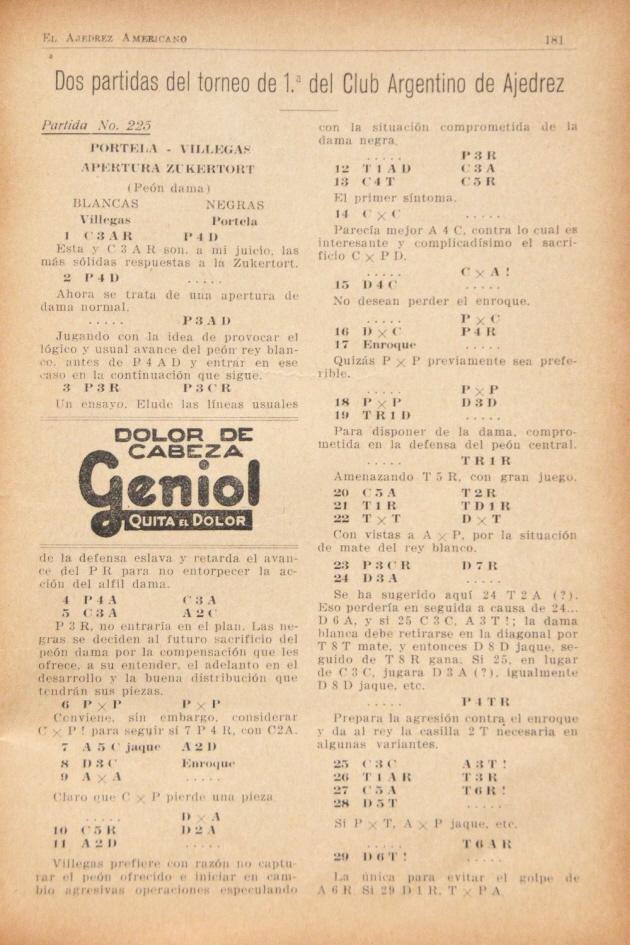
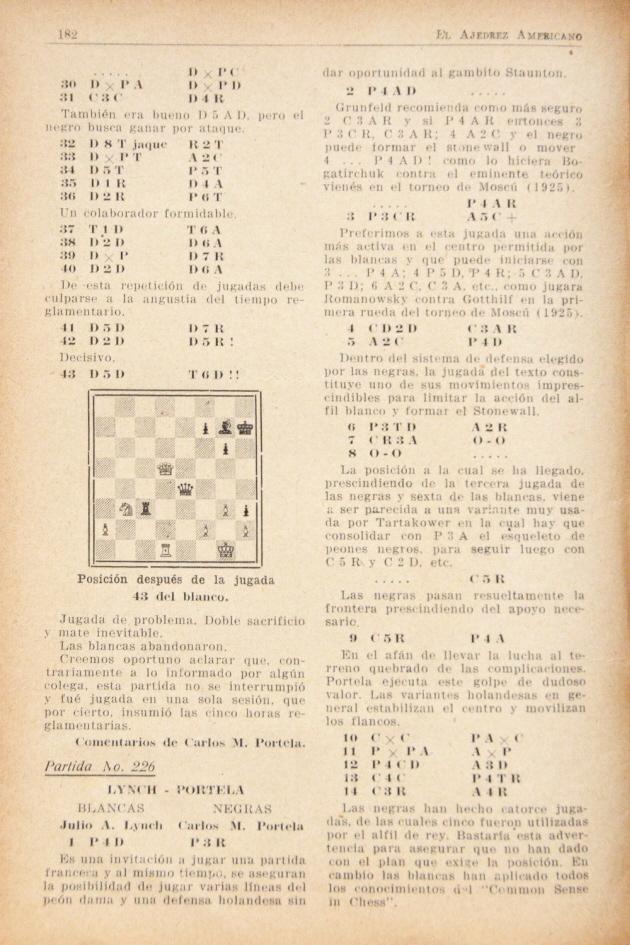
Mr Bauzá Mercére also points out that the familiar ‘Novotny move’ 43 Rd5 in this position ...
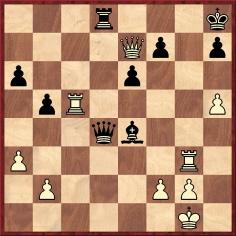
... did not occur, since Eliskases preferred to play 43 Re5. The game with Eliskases’ annotations was published on pages 314-316 of the October 1929 Wiener Schachzeitung.
Erich Eliskases – Hölzl1 e3 c5 2 c4 Nc6 3 Nf3 Nf6 4 d4 e6 5 Nc3 d5 6 a3 a6 7 Bd3 dxc4 8 Bxc4 b5 9 Ba2 cxd4 10 exd4 Be7 11 O-O O-O 12 Be3 Bb7 13 Qe2 Qc7 14 Rac1 Rad8 15 Rfd1 Rfe8 16 h3 Bf8 17 Bb1 Qb8 18 Bg5 Be7 19 Ne4 Nd5 20 Nc5 Bxg5 21 Nxg5 Nf6 22 Nge4 Ne7 23 Nxf6+ gxf6 24 Qg4+ Ng6 25 h4 Bc8 26 h5 Qf4 27 Qe2 Ne7 28 Ne4 Nd5 29 Rc5 Kh8 30 Rd3 f5 31 Rf3 Qb8 32 Ng5 Re7 33 Rg3 Nf4 34 Qe3 Qd6 35 Rc6 Qb8 36 Bxf5 Bb7 37 Rc5 Qd6 38 Be4 Nd5 39 Bxd5 Bxd5 40 Nf3 Bxf3 41 Qg5 Qxd4 42 Qxe7 Be4 43 Re5 Resigns.
The game is often misdated 1931.
(7730)

Black to move
Further to a correspondent’s contribution in C.N. 7730, Andrew Bull (Cheltenham, England) writes:
‘While 43...Rd3! in Villegas v Portela is an elegant and decisive move, it is not an example of the Plachutta theme as I understand it. To quote from the 1984 edition of The Oxford Companion to Chess by Hooper and Whyld:
- Plachutta theme: “It is similar to the Wurzburg-Plachutta theme, but with sacrifice on the intersection square.” (Page 256.)
- Wurzburg-Plachutta theme: “A black line-piece defends square A and another black line-piece of like movement defends square B. These pieces defend along lines that intersect, and if either piece is moved to the intersection square it will prove unequal to the task of defending both square A and square B.” (Page 380.)
In Villegas v Portela, the queen and rook defend along the same line, rather than lines which intersect; there are no squares which could be identified as A and B to fit the definition above, and if White captures the rook with either queen or rook, the capturing piece is not interfering with the other.’
From Michael McDowell (Westcliff-on-sea, England):
‘The Villegas v Portela position does not show the Plachutta theme, which in its basic form is a three-move theme defined as mutual interference of like-moving men (R+R, R+Q, B+Q) introduced by a sacrifice on the square of intersection. The point is that each defender has duties to perform, and in capturing the sacrificed piece it takes on the duties of the other piece and becomes overloaded. In the Villegas v Portela position, if the queen or rook captures on d3 that piece does not take over the duty of the other piece in addition to its own, but simply abandons its own duty (the guarding of g2 or e1 respectively). 43...Rd3 is essentially just a fork, although a little more interesting than normal.’
A contribution from Luc Winants (Boirs, Belgium):
‘The Plachutta and Novotny themes are undoubtedly related, but I do not regard the former as a sub-category of the latter.
- A Plachutta is an interference of two pieces which move similarly, with a sacrifice on the cutting-point.
- A Wurzburg-Plachutta is an interference of two pieces which move similarly, but without a sacrifice on the cutting-point.
- A Novotny is an interference of two pieces which move differently, with a sacrifice on the cutting-point.
- A Grimshaw is an interference of two pieces which move differently, but without a sacrifice on the cutting-point.
To quote from page 412 of Le Lionnais and Maget’s Dictionnaire des échecs (Paris, 1967):
“Ce thème [Wurzburg-Plachutta] est au thème Plachutta ce que le Grimshaw est au Novotny.”
See also page 99 of the second edition of The Oxford Companion to Chess, under “Cutting-point themes”.’
(7734)
Below is Luc Winants’ column in La Libre Belgique of 12 November 2011, which he sent us at the time:
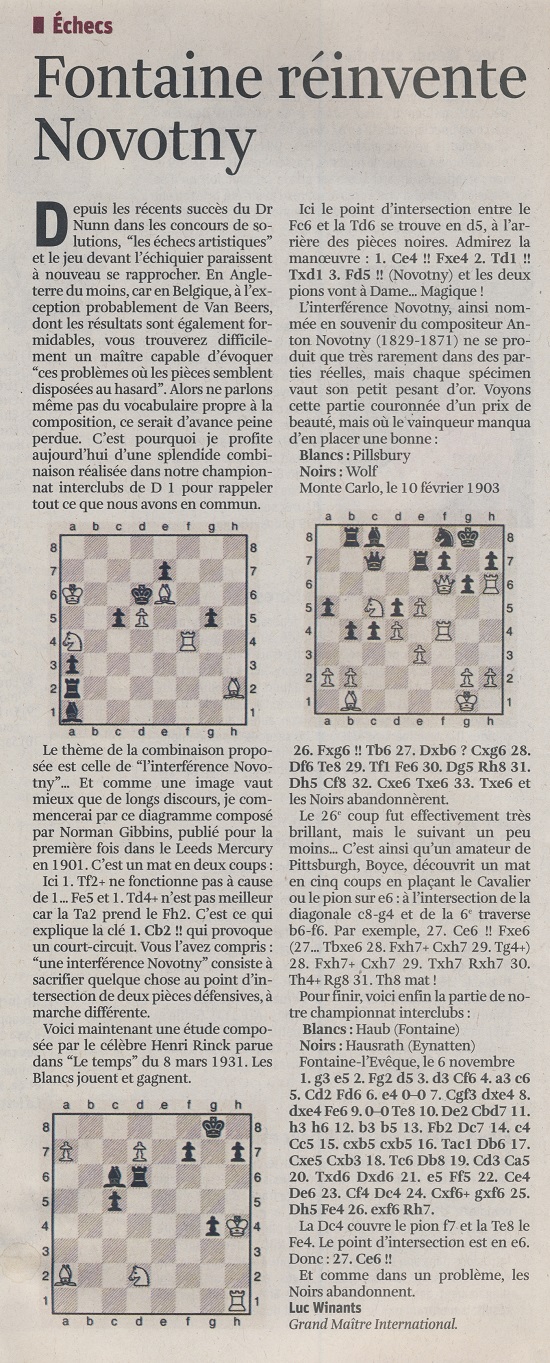
The game position after 26...Kh7:

To the Chess Notes main page.
To the Archives for other feature articles.
Copyright: Edward Winter. All rights reserved.